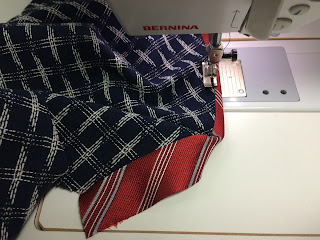Friday I attended a lecture by
Marla Kazell, couture sewing teacher. Her lecture was information rich. She lectured and illustrated one technique after another. Some I knew and had forgotten. Some were just what I needed. And some I just have to try out soon. It got me thinking.
There are sewing teachers who inspire creativity (Diane Ericson, Mary Ray). There are those who inspire style (Linda Lee, Marcy Tilton, Pam Howard) I want to copy. Some just make sewing look like great fun (many). But I'm always on the look-out for a new technique. Aren't you?
So here are two I've tried recently.
Single-welt pocket
At
Sew Kansas Linda Lee demonstrated the single-welt pocket. I've seen welt pocket demonstrations before and I've even made a few myself. None that I really loved. None that inspired me to cut into a nearly finished almost perfect garment and hope that everything would be OK.
After watching Linda Lee, I knew I had to try again. This one creates a clean finish on the inside of the pocket, as well as on the inside of the garment. It works equally well on lined and unlined garments. And of course the exterior looks darned good too!
Like all good sewers, Linda Lee preached the making of samples. Something I do not usually enjoy. This time though I decided to add some fun to it by using pretty fabrics and then decorating it:
I took fairly good notes but did not have time to try this on my own until weeks after I learned from Linda. I was really glad that I decided to purchase
Sew Confident from Linda Lee, as it provides the details of this pretty pocket.
Sew Confident contains not only techniques but lots of inspired style. If you like the style and techniques applied in The Sewing Workshop, then you will love this monthly series of tutorials and eye-candy.
Hong Kong Finish on a Sleeveless Top:
As mentioned above, Marla Kazell's lecture was chocked full of techniques. I came home wanting to try them all. First up, the Hong Kong finish on a sleeveless garment.
Many times I have substituted binding for facing, especially on an unlined garment. I've used one of these binding techniques:
- Cut the seam allowance off. Sew bias binding to the garment edge, right sides together, usually with a seam allowance that is 1/4" up to 1/2". Wrap around to the wrong side and slip stitch in place. This is just a standard quilt binding technique that can be varied by folding the bias wrong sides together before applying it. This adds bulk but is desirable for durable quilt bindings.
- Same as the above, but sew the bias to the wrong side of the garment. Wrap to the front, folding under the raw edge. Top-stitch on the right side. In both techniques 1 and 2, the binding shows on the right side.
- Leave the seam allowance and apply a bias binding sewing (right sides together) on the seam line. Trim seam allowance as desired. Wrap binding to the back so that none of the binding shows on the right side. Top-stitch or hand-stitch in place.
Marla presented a variation on the 3rd technique. Once finished the binding is only visible on the inside.
As it happens, I had a top with exterior binding that I did not like anyway, so I replaced it, trying out her technique. I am very pleased with the results even though I could not find any remnants of the original fabric. I used a blue batik.
First she cut the bias strip. Then she sewed it to the armhole right at the usual seam line (5/8 inch). Next she trimmed the seam allowance to 1/4 inch. After that, she wrapped binding around the raw edge and stitched in the ditch from the right side. At this point I was scratching my head, thinking, but the sleeve will be too tight!
There was more. She trimmed the raw edge of the binding on the wrong side as closely as possible and then wrapped the binding to the inside, one more time. At this point the binding is entirely on the inside. I pressed it in place and top-stitched. Pretty cool technique, Marla!
 |
| Binding is inside. Only top-stitching shows on the outside. You can barely see the blue batik I used for the binding, and since I have arms, it will never show. |
 |
| This is the way it looks before it is folded a second time. |
 |
| Pressing the binding to the inside before top-stitching |
Marla was the technical consultant for this well-known and well-loved book by Roberta Carr on couture sewing:
Marla worked with Roberta Carr for many years before she died. In fact, Marla was bequeathed her closet! Several of Roberta's garments were used to illustrate couture techniques during Marla's lecture.
If you ever have a chance to hear Marla speak, do so. She is the real deal on couture sewing and like most good teachers, she is generous and articulate.
Marla Kazell also has a bi-monthly newsletter that is available for free.
Also if you do not have this must-have book in your sewing library, I recommend it to you. I cannot wait to try more of Marla's (and Roberta's) techniques.
Marla's lecture did not inspire me to buy more patterns or more fabric (my usual response to an enjoyable class), but it did inspire me to sew better. And that's a good thing.




































